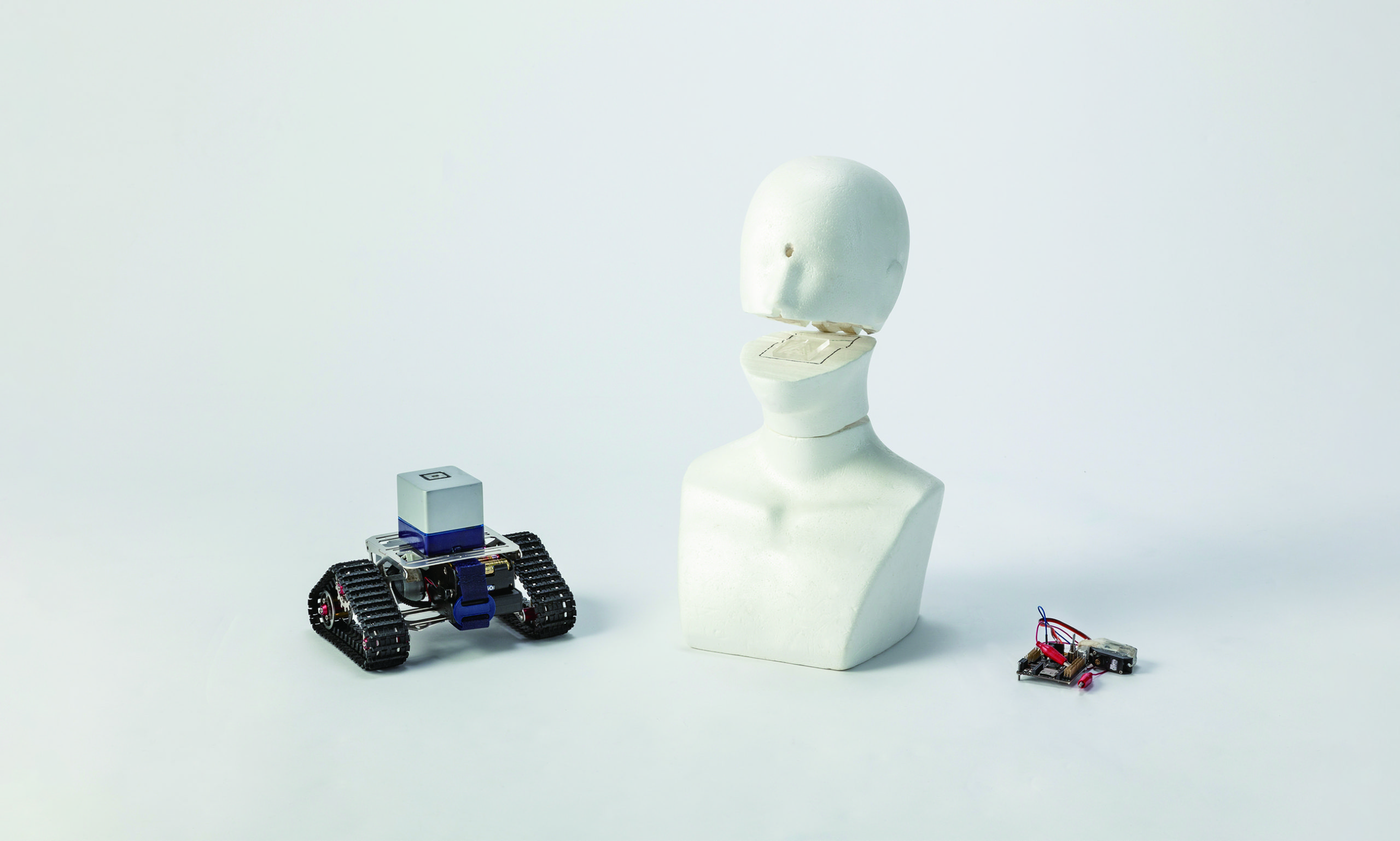バイオハイブリッドロボットBiohybrid Robot
機械情報工学科 Department of Mechano-Informatics

人類は、社会のニーズに合わせてさまざまなシステムや技術を開発してきました。その一方で、生物に見られるような特異的な機能を工業的に利用する段階には未だ至っていません。たとえば、分子レベルで認識可能な超高感度、高選択性を持つイヌや昆虫のような嗅覚センサ、自己増殖や自己修復を繰り返す細胞のようなリアクター、エネルギー効率の高い動きや情報処理を行なう筋肉や脳など、生物の持つ優れた機能の人工的な構築には大きな課題が残されています。
課題解決の一例として、現状で人工物だけでシステムを実現するのが難しいのであれば、自然界に存在している生物のパーツそのものを、人工物と融合した「バイオハイブリッド」なシステムを構築する方法があります。
ラウンジでは、機械情報工学科竹内昌治研究室がこれまで研究してきたバイオハイブリッドロボットに関する成果を展示します。
蚊の受容体(触角)を用いた匂いセンサー搭載移動ロボット
2019
制作:三澤宣雄・藤井聡志
提供:竹内昌治研究室
所蔵:東京大学大学院情報理工学系研究科 知能機械情報学専攻
特定の匂いに反応する細胞を使ったセンサーを搭載したロボット
2016
制作:三澤宣雄・光野秀文
提供:竹内昌治研究室
所蔵:東京大学大学院情報理工学系研究科 知能機械情報学専攻
骨格筋組織によって駆動するロボット
2018
制作:森本雄矢
提供:竹内昌治研究室
所蔵:東京大学大学院情報理工学系研究科 知能機械情報学専攻
Engineers have created various kinds of machines such as smart phones, humanoid robots, self-propelled vehicles, etc. However, there are still big hurdles to build a system that demonstrates attractive functions appeared in biological systems, such as single molecule recognition, highly efficient biomolecular production, biocompatibility and self- healing/self-reproducing ability, etc.
To achieve these functions, we have studied “biohybrid” systems that harnessthe living system within artificial systems.
Here are three biohybrid robots developed by Shoji Takeuchi’s research group at the Department of Mechano-Informatics.
A mobile robot with an odorant sensor using a olfactory receptor of an insect
2019
Production: Nobuo Misawa/ Satoshi Fujii
Courtesy: Shoji Takeuchi Research Group
Collection: Department of Mechano-Informatics, Graduate School of Information Science and Technology, The University of Tokyo
A robot with a cell-based odorant sensor
左上) 蚊の受容体(触角)を用いた匂いセンサー搭載移動ロボット
中央・右上)特定の匂いに反応する細胞を使ったセンサーを搭載したロボット
右下)骨格筋組織によって駆動するロボット
Top left) A mobile robot with an odorant sensor using
a olfactory receptor of an insect
Top right, Middle) A robot with a cell-based odorant sensor
Bottom right) A biohybrid robot driven by skeletal muscle tissue
2016
Production: Nobuo Misawa/ Hidefumi Mitsuno
Courtesy: Shoji Takeuchi Research Group
Collection: Department of Mechano-Informatics, Graduate School of Information Science and Technology, The University of Tokyo
A biohybrid robot driven by skeletal muscle tissue
2018
Production: Associate Professor Yuya Morimoto, Department of Mechano-Informatics, Graduate School of Information Science and Technology The University of Tokyo
Courtesy: Shoji Takeuchi Research Group
Collection: Department of Mechano-Informatics, Graduate School of Information Science and Technology, The University of Tokyo

